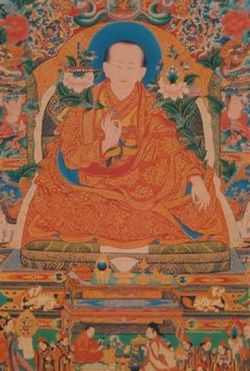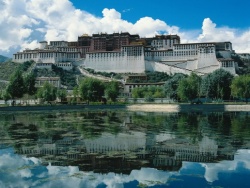Riwo Choling Monastery
Sangye Gyatso’s Sabbatical
Sangye Gyatso (1653-1705) was remarkably ambitious. He was born in 1653, about ten years after the Dalai Lama gained power over Tibet. Not only did he assume the role of governance (sde srid) in 1679 at the young age of 26, he was a prolific scholar who wrote definitive books on Tibetan medicine, astrology and history. His rule was ambitious as he completed the construction of the Potala, established the Chagpori medical school and other governmental reforms. He also hid the Fifth Dalai Lama’s death in 1682 for most of his reign to avoid interference from foreign powers such as the Qing Empire.20
Sangye Gyatso was a nephew to Trinley Gyatso (ESG, 112), the regent appointed by the Fifth Dalai Lama after Sonam Rabten. Sangye Gyatso first came to the Potala in 1660, when he was eight, and was personally looked after and mentored by the Dalai Lama himself (HPP, 453). In 1675 he was asked to become a regent, which he declined in favor of tending to a spiritual life (HPP, 455). In 1679, after the interim desi was no longer able to serve, he finally relented to accepting the desi position after the Fifth Dalai Lama demanded it based on the Lhamo oracle’s advice, his relation to the former desi and predictions in various termas21 (HPP, 455).
Riwo Choling is a remote, but relatively large, Gelug monastery south of Lhasa in the Yarlung valley region. The origin of Riwo Choling monastery goes back to the 14th century when Je Tsongkhapa was traveling through the area with some other monks. This area contains two mountains and Je Tsongkhapa remarked that, since it was shaped like a sword, in the future it would be a place amicable to learning.22 The sword is the implement of the Bodhisattva of Wisdom, Manjushri, and represents discriminating wisdom.
Yarlung valley contains many important holy sites such as Tradrug (khra 'brug), the first temple in Tibet created by the Dharma king Songtsen Gampo. The Yarlung valley and its temples have been very important spiritually and geopolitically throughout Tibetan history. The Fifth Dalai Lama and Desi Sangye Gyatso both integrated centers of the dynastic period into their ritual calendar to reconstruct themselves in the tradition of “rightful perpetuators of the Buddhist tradition in Tibet” (TF, 33). The Ganden Phodrang invested a lot into restoring Tradrug, such as furnishing a golden roof and sponsoring daily rituals such as butter lamp offerings similar to that done in Jokhang in Lhasa (TF, 34).
Due to the geographic proximity of Tradrug to Riwo Choling, monks from Riwo Choling primarily rendered service to Tradrug (TF, 31). Riwo Choling was known as one of the residences of Dorje Shugden (TF, 110), and Dorje Shugden was also known as the protector (srung ma) of Riwo Choling (TF, 312). The village below Riwo Choling is called Tsharu, which is 2 kilometers south of Tradrug, the oldest temple in Tibet built by Songtsen Gampo. From Choepel’s pilgrimage guide (GCJ, 48):
This monastery was initially founded by Je Tsongkhapa’s disciple Khedrup Dondrup Palzang in the 15th century. At first it had one college with 8 monks but gradually grew to one hundred monks. As this is the monastery famed for where the Desi Sangye Gyatso entered the religious life, there is a three story fortress of his on the side. As Desi Sangye Gyatso looked after this monastery it came to be protected by the government. Monks of this monastery were permitted to study at the three great monasteries (Ganden, Sera, Drepung), Ngari Dagpo college, and traditional Tibetan medical schools such as Chagpori (lcags po ri). You will encounter here a one story building that hosts a silver reliquary ornamented by gold which contains the skull [broken into 8 pieces that has 21 self-arisen Taras visible) of Marpa’s son, Darma Dode, placed by the Fifth Dalai Lama at this monastery. You will also find a three story Maitreya statue and a monk assembly hall that has 30 pillars [which indicates the size is large].
Tragically, Sangye Gyatso’s life was cut short after the resumption of power by Qoshot Mongolians lead by Lhazang Khan, a descendent of Gushri Khan. There were controversies about him hiding the Fifth Dalai Lama’s death from the Qing emperor, Kangxi, and finally the situation with the Sixth Dalai Lama he recognized without meeting the Mongolians’ criteria. However, many of his and the Fifth Dalai Lama’s reforms left their mark on Tibet and its monastic and various institutions for centuries to come.
20 This caused a strong response from the Qing Emperor Kangxi, who ordered an edict built at the Potala. See Ching Dynasty Inscriptions at Lhasa by Hugh Edward Richardson for a translation of this edict.
21 The claim made in the terma is that the Fifth Dalai Lama was the reincarnation of the 8th century king of Tibet, Trisong Detsen, and Desi Sangye Gyatso was the reincarnation of his son, Mu-ne Tsan-po (ESG, 114).
22 Source: 3/2008 interview with an anonymous visitor to Riwo Choline in the 1940s.

